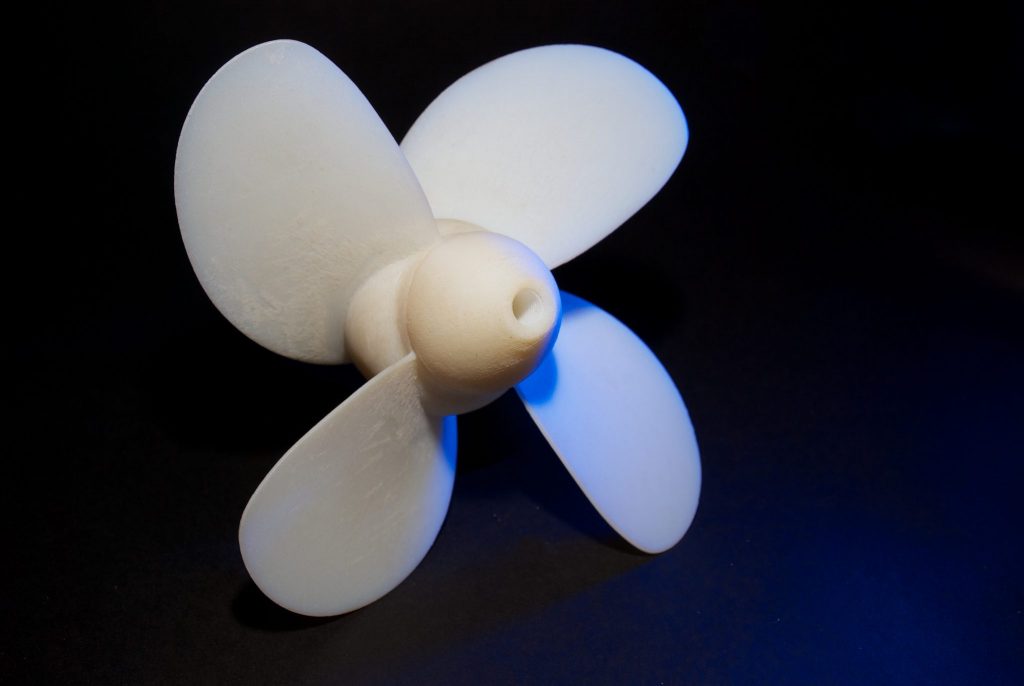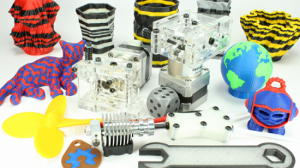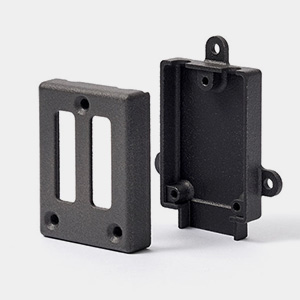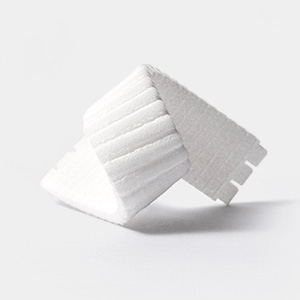Shipboard 3D Printing Expanding Worldwide
Polar waters, icy environments and seemingly harsh surroundings make the Arctic one of the most difficult marine settings to work in, especially with regards to ship and marine technology. This complexity demands some risk-based designs and frameworks for safe and sustainable technology that can survive in harsh ecosystems. Very difficult sailing conditions in Arctic or Antarctic waters, offshore oil rigs and fleets travelling in harsh seas, has propelled governments and companies to include additive manufacturing in structures made to survive severe maritime conditions. In 2014 the United States Navy began considering bringing 3D printers on board their ships, they envisioned a not so distant future when they could print spare parts, miniature combat drones, and even organs or other body parts, on Navy vessels in the middle of the sea. While In 2017, the US Coast Guard used 3D printers to create spare parts (not normally kept on vessels and which may be difficult to source) on board its ships. Currently, 3D printers are available for crew use on five Coast Guard cutters as well as at several shore units, including Base New Orleans and the Surface Forces Logistics Center Engineering Services Division in Baltimore.
Similarly, Coast Guard academy professor, Ron Adrezin, uses the technology for operations in remote areas aboard the Cutter Healy, a 420-foot icebreaker that goes on research missions in the Arctic and Bering seas. On another front, International Submarine Engineering (ISE) used Sciaky’s Electron Beam Additive Manufacturing (EBAM) technology to produce a titanium Variable Ballast (VB) tank for an arctic submarine. It’s all about having a 3D printer for full access and on site to create some hard-to-get parts that come in really handy when bad weather conditions keep ships from moving, severe storms break something in the middle of the sea or ice threatens entire fleets.
In 2015, Canadian company Oceanic Consulting Corporation, a subsidiary of Fleetway, used 3D printing to create bespoke replacement parts and modify them as required in house, for many of their research and development projects to study and improve ships, fixed and floating offshore structures and other advanced marine systems. Located in St. John’s, Newfoundland, the company applies 3D technology to realize some ambitious projects. Their ongoing need to create accurate scale models and simulate real-world environments, made Oceanic search for the perfect-fit 3D printer. The research and design team on Oceanic works towards improving the safety of vessels navigating in harsh sea ice environments, managing extreme cold temperatures and large ice loads. Combining expertise in mechanical engineering, experimental research and numerical simulation in Arctic Engineering with 3D printing could be just what they needed to increase efficiency and reduce costs for some of their projects.
The company purchased a Stratasys 3D printer from Javelin Technologies, for fabricating essential components as they usually work under very tight timelines due to their customers’ needs for delivery in short time periods -usually just a few weeks-. Using the Stratasys 3D printer, together with SOLIDWORKS 3D CAD Software, allows Oceanic specialists to quickly turn concepts into physical parts, giving them new opportunities to do work in house that was once sent to outside suppliers. Making the complexity of parts fabrication possible with the 3D printer has allowed for enhanced sophistication in physical model experiments, which allows for improved accuracy and happier clients.
Oceanic claims they save time using SOLIDWORKS and doing their own 3D printing to validate designs quickly to meet demanding project deadlines. They are also always testing and pushing the 3D printer and the capabilities of the build material to their limits, sometimes designing very thin parts. The fabrication team was already accustomed to Javelin’s high level of service and support, so working with the company was an obvious choice.
Working in an often harsh marine environment presents extra challenges, and having a 3D printer allows Oceanic to efficiently print replacement parts and modify them as required. It is now possible to 3D print parts that were once only machined, so designers can add detail and features that would otherwise be very expensive – even impossible – to machine. Examples include mechanical linkages, rudders, mounting brackets, props, and even custom instrumentation.
The scope of some of Oceanic’s projects is to develop guidelines for the safe and sustainable design of ships and fleets that need to venture into harsh marine environments, by combining practical knowledge, state of the art engineering methods, and fundamental hazard concept design. That is why Oceanic has access to a comprehensive suite of world class marine research facilities in Newfoundland and Labrador, which include the National Research Council of Canada’s Ocean, Coastal and River Engineering Portfolio, and Memorial University’s Ocean Engineering Research Centre and Marine Institute. Whether it has been contracted to study ships, boats, offshore structures, or other marine systems, Oceanic provides clients with the expertise, advanced facilities, and now 3D printing technology to realize even the most ambitious project.

NOAA: Formlabs Form2 Printer mounted to the GyroPro stabilization platform, used for mapping deepwater areas in the Caribbean and South Atlantic Bight
Going one step further and in a more recent attempt to 3D print in a dynamic environment, in 2018 the US Department of Commerces’ National Oceanic and Atmospheric Administration (NOAA) sent a team on board the NOAA Ship Okeanos Explorer with a Stereolithography Apparatus (SLA) style printer which uses an ultraviolet (UV) curable liquid and a laser to cure the liquid layer by layer, to map deepwater areas in the Caribbean and South Atlantic Bight. Harsh marine areas pose quite a challenge for engineers and designers to develop technology that will aid ships, marine structures and communities to work in some of the worst conditions in the planet, but having accesible 3D printing technology either in house for restoring and creating spare parts or even on board can become life-changing.
Ceramics 3D Printing Robots May Save Ancient Relics
 3D printing continues to assist in the preservation and restoration of historical relics, with industrial robotics and alternative materials offering even more potential. Chinese researcher Jia-zheng Zhu, of Nanjing Normal University, explores the topic further in ‘Application of 3D Printing Industrial Robot in Ceramic Relic Protection and Repair,’ along with alerting us to the sense of urgency in the matter of managing artifacts in China.
3D printing continues to assist in the preservation and restoration of historical relics, with industrial robotics and alternative materials offering even more potential. Chinese researcher Jia-zheng Zhu, of Nanjing Normal University, explores the topic further in ‘Application of 3D Printing Industrial Robot in Ceramic Relic Protection and Repair,’ along with alerting us to the sense of urgency in the matter of managing artifacts in China.
Zhu points out that while cultural relics have obvious historical and artistic value in China that must be preserved, they must also be duly protected from their physical environment. Fighting the elements is an ongoing issue in relation to ancient and older originals that we don’t want to see losing further integrity—but it is often a losing battle. And traditionally, repairing them also requires complex care by experts, employing intricate, time-consuming techniques.
3D scanning came along and almost magically erased issues in preservation, as pieces could be scanned and replicated—giving museums the option to lock away originals, almost like the concept of wearing paste jewelry while keeping the true valuables in a safe somewhere; in this case, however, there is no deception in making such copies as one, the public is generally fascinated in hearing about the technology—and two, replicas make a wide range of works more accessible to enthusiasts, curators, students, and research scientists.
Zhu states that both 3D scanning and 3D printing industrial robots have already been in wide use and offer enormous advantages because they can collect data for making replicas without damaging relics such as those made in ceramic, and in making repairs they can be extremely accurate. Currently, industrial robots are performing the following tasks for repairs at Nanjing Museum:
- Generating robot motion sequences
- Reverse modeling of broken pieces
- Temperature control sintering of printing parts and post-processing
- Controlling feed pressure tanks
Once replicas are made, surfaces can be colored, and they can be finished as required for total completion without any threat of further destruction or disintegration during the process.
“With its high efficiency, precision and non-destructive characteristics, it can play a huge role in the field of cultural relics restoration,” states Zhu regarding 3D printing.
For this application, those in charge of restoring relics are relying on the 3D printing benefits such as affordability and speed in production, the ability to customize as needed, along with ease in transferring data—for example, one museum curator may transfer 3D files of a replica to another curator (who may even be halfway across the world from them!) so they can print the same thing for study or another exhibit.
Repairs can also be made more easily, and with minimal to no waste as scans are performed, with reverse reconstruction helping to fix or rebuild pieces.
“The work of reverse modeling is mainly divided into two aspects, one is spatial position reconstruction. And the other is surface reconstruction, which is the appearance texture reconstruction. For the former, there are quite a few techniques that can be solved, and the latter, the appearance texture reconstruction, is also an important part of reverse modeling,” states Zhu.
There are still limitations in the uses of this technology and resulting processes. Accessibility is a major factor, despite the growing popularity of 3D technology virtually everywhere. 3D scanners and the required accompanying technology may still be hard to find—in reality—and once that obstacle is eliminated, there must then be someone available who knows how to use all the hardware, software, and materials—or immediate accessibility to education regarding scanning and printing. Along with finding experienced users, finished of the 3D printed models is another issue as there may be a need for multiple colors, and painting by an expert is required in many cases. Preservation is challenging but maintaining pieces is even more so as there are so many unknown variables.
“During the repair process, the risk of secondary damage caused by processes such as overturning and replenishing in the traditional process is avoided. At the same time, 3D printing industrial robots can adapt to the various needs of different materials and cultural relics, which can greatly improve the efficiency of traditional cultural relics restoration,” concludes Zhu. “In recent years, it has gradually popularized and better integrated 3D printing technology into cultural relics restoration programs. Therefore, 3D printing technology is very necessary in the field of cultural relics repair. This also requires the accumulation of experiments by many professionals, summing up experience and perfecting this technology.”
History is important to humans. We protect memories on the individual level whether still using more old-fashioned photo albums and scrapbooks or focusing on social media where our photographs and captions can be saved while taking up relatively little space—and also where images never become curled or yellowed on paper. But the history of the human race, as well as so much that has been contributed to art, science, engineering, and more along the way, is deeply treasured by those who realize what a privilege it is to be able to see (and at times, even hold) ancient remains and artifacts.
Back in the 80s when 3D printing was arriving on the scene in its most rudimentary form, chances are, no one was thinking about preservation of cultural relics; however, it has allowed for this process to evolve in many different forms. Originals are able to be kept safe while replicas are displayed in museums, or at exhibits—and in such a form where they can be handled for educational purposes in comparison to original pieces that must be kept away from any activities or environment allowing them to degrade further. Art and history enthusiasts also have more access to original works as they can take advantage of 3D scanning technology to print out and own/display their own precise replicas.
What do you think of this news? Let us know your thoughts! Join the discussion of this and other 3D printing topics at 3DPrintBoard.com.
[Source / Images: ‘Application of 3D Printing Industrial Robot in Ceramic Relic Protection and Repair’]
HP Celebrates 10 Million Printed Parts Milestone
With their multi-jet fusion technology really taking off, HP is hitting great strides in the 3D printing world. In fact, the technology is doing so well that HP is celebrating having printed 10 million parts in this year alone. The world-famous company is commemorating the occasion by also adding in the launch of a metal […]
The post HP Celebrates 10 Million Printed Parts Milestone appeared first on 3D Printing.
Nanoscribe joins photonics and quantum research program MiLiQuant
Andrea Salvatori and WASP create 3D printed ikebana vases
This Steampunk Bracelet Features Moving Gears and a #Trinket #WearableWednesday
Super fun project from Jorvon Moss on Hackster.io:
This project has been on my mind for months I found a Bracelet on Thingaverse made out of gears which I immediately. printed and began wearing and playing with it. its more of a fidget toy something you can turn with your hands, but then I thought, why not add a motor? So I did and the result has been amazing.
 Every Wednesday is Wearable Wednesday here at Adafruit! We’re bringing you the blinkiest, most fashionable, innovative, and useful wearables from around the web and in our own original projects featuring our wearable Arduino-compatible platform, FLORA. Be sure to post up your wearables projects in the forums or send us a link and you might be featured here on Wearable Wednesday!
Every Wednesday is Wearable Wednesday here at Adafruit! We’re bringing you the blinkiest, most fashionable, innovative, and useful wearables from around the web and in our own original projects featuring our wearable Arduino-compatible platform, FLORA. Be sure to post up your wearables projects in the forums or send us a link and you might be featured here on Wearable Wednesday!
3D Printing News Briefs: April 3, 2019
To kick off this week’s first edition of 3D Printing News Briefs, we’ve got a fun project to share with you, before moving on to events, business, education, and software. Materials Australia is hosting a 3D printing conference in Melbourne this summer, while formnext + PM South China will debut in September of 2020 and the original formnext is continuing to grow at record speed. Evolve Additive Solutions will expand its Rochester facility, and Mauritius is unveiling its second 3D printing center. The founders of rigid.ink launched a new online AM course, and Magnitude Innovations has released a new metal 3D printing software application.
Cool 2D-3D Project on imgur
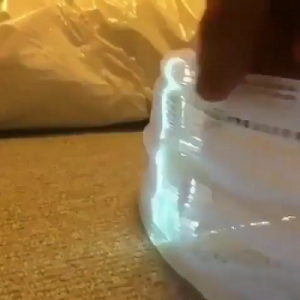 TheSparklyGhost, a user on the popular online image sharing community of imgur, recently posted a brief video of a really neat project titled “2D project on a 3D printed object.” I’m going to do my best to explain this, but it’s better if you watch the short video posted on Imgur, which has been viewed over 81,800 times in the last seven days. TheSparklyGhost 3D printed a long white object, which at first glance looks kind of like a curved wall but is actually an extended cutout shape of a person with legs akimbo. Then, the print is moved back and forth over a thin projection line, which makes it look like a 2D person walking.
TheSparklyGhost, a user on the popular online image sharing community of imgur, recently posted a brief video of a really neat project titled “2D project on a 3D printed object.” I’m going to do my best to explain this, but it’s better if you watch the short video posted on Imgur, which has been viewed over 81,800 times in the last seven days. TheSparklyGhost 3D printed a long white object, which at first glance looks kind of like a curved wall but is actually an extended cutout shape of a person with legs akimbo. Then, the print is moved back and forth over a thin projection line, which makes it look like a 2D person walking.
The video has received a wide variety of comments in the last week. Some users just expressed their awe, while one asked if the STL for the print was available and some offered suggestions like “make a 3D projection on a 4D printed object” and “Now make it moon walk.” However, not everyone was impressed, with one user asking if the cost was worth it and another saying, “k this is sorta cool and all but what will this do for you?” Anyone have a response to that?
Materials Australia Hosting 3D Printing Conference
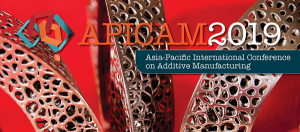 This summer, Materials Australia, the peak representative body of the country’s materials science and engineering profession, will be curating an additive manufacturing conference in Melbourne. The Asia-Pacific International Conference on Additive Manufacturing (APICAM) 2019 will be held from June 30th to July 3rd at RMIT University. The conference, in its second iteration, will include keynote presentations by AM experts, a poster presentation, a networking hub, workshops, exhibitors, and multiple receptions.
This summer, Materials Australia, the peak representative body of the country’s materials science and engineering profession, will be curating an additive manufacturing conference in Melbourne. The Asia-Pacific International Conference on Additive Manufacturing (APICAM) 2019 will be held from June 30th to July 3rd at RMIT University. The conference, in its second iteration, will include keynote presentations by AM experts, a poster presentation, a networking hub, workshops, exhibitors, and multiple receptions.
According to the website, “The purpose of APICAM2019 is to provide a focused forum for the presentation of advanced research and improved understanding of various aspects of additive manufacturing. This conference will include invited lectures from internationally distinguished researchers, contributed presentations and posters.”
Early bird registration is available until May 1st.
2020 Debut of formnext + PM South China
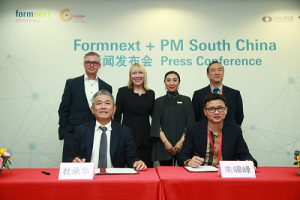 Additive manufacturing continues to grow more popular in China, with domestic industry sales estimated to reach $2.96 billion in 2020, and the government is paying attention. Now, from September 9-11, 2020, the first edition of Formnext + PM South China will debut at the new Shenzhen World Exhibition and Convention Center, which is said to be the largest exhibition venue in the world. The event will be jointly organized by Guangzhou Guangya Messe Frankfurt Co Ltd and Uniris Exhibition Shanghai Co Ltd, and will aim to help AM industry players open up new business opportunities in innovative equipment, processes, and advanced materials. Over 10,000 visitors are expected to attend, with more than 200 exhibitors from around the world.
Additive manufacturing continues to grow more popular in China, with domestic industry sales estimated to reach $2.96 billion in 2020, and the government is paying attention. Now, from September 9-11, 2020, the first edition of Formnext + PM South China will debut at the new Shenzhen World Exhibition and Convention Center, which is said to be the largest exhibition venue in the world. The event will be jointly organized by Guangzhou Guangya Messe Frankfurt Co Ltd and Uniris Exhibition Shanghai Co Ltd, and will aim to help AM industry players open up new business opportunities in innovative equipment, processes, and advanced materials. Over 10,000 visitors are expected to attend, with more than 200 exhibitors from around the world.
“With the expertise from its brand name shows, Formnext in Frankfurt, Germany, and also PM China in Shanghai, the newly formed fair will be one of a kind in South China,” Mr Hubert Duh, Chairman of Guangzhou Guangya Messe Frankfurt Co Ltd, said in a press conference to celebrate the launch of the event. “The synergy from the two fair brands will facilitate the exchange of ideas between industry professionals and bring a positive impact to the manufacturing sector.”
formnext in Frankfurt Continuing Record Growth
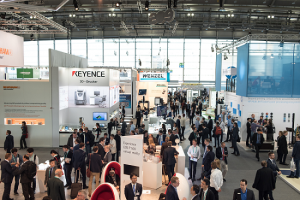 In the meantime, the world’s leading international AM trade fair, formnext, is still going strong, and is in fact expanding and developing at record speed this year along the whole process chain. As of March 2019, over 500 exhibitors, many of which are international and 147 of which are new, had already registered for the event, which will be held in Frankfurt from November 19-22. This means that the amount of space the event will cover this year is already more than the final size of formnext 2018, which is why formnext 2019 will take place for the first time in the more modern Halls 11 and 12.
In the meantime, the world’s leading international AM trade fair, formnext, is still going strong, and is in fact expanding and developing at record speed this year along the whole process chain. As of March 2019, over 500 exhibitors, many of which are international and 147 of which are new, had already registered for the event, which will be held in Frankfurt from November 19-22. This means that the amount of space the event will cover this year is already more than the final size of formnext 2018, which is why formnext 2019 will take place for the first time in the more modern Halls 11 and 12.
Other changes include an expansion of the Discover3Dprinting seminar series, which is organized with the ACAM Aachen Center for Additive Manufacturing and meant for medium-sized companies looking to adopt AM. The Startup Challenge, AM4U platform of career opportunities, the ideas competition “purmundus challenge,” and the BE-AM Symposium, which focuses on 3D printing in the construction industry, are all continuing and being expanded, and formnext’s content partner TCT will again discuss current developments and trends in the conference program. Additionally, this year the US will be the first partner country represented at the event, and special highlights for American guests, like the “AM Standards Forum,” will be included.
Evolve Additive Solutions to Grow New York Operations
 3D printing OEM Evolve Additive Solutions, a Stratasys spin-out company, is headquartered in Minneapolis but operates its materials technology center in Brighton, New York. The company will be expanding its Brighton operations, according to an announcement by Empire State Development (ESD), which will allow the creation of 60 new jobs over the next five years in the Finger Lakes region. The company recently raised $19 million in equity funding with lead investors LEGO Brand Group and Stanley Black & Decker, which complements its efforts to commercialize its Selective Thermoplastic Electrophotographic Process (STEP) 3D printing process and expand its Brighton office by 7,000 square feet, with another 13,000 added later. Supporting the development and growth of high-tech industries, such as 3D printing and advanced manufacturing, is an important part of the Finger Lakes Forward economic development plan.
3D printing OEM Evolve Additive Solutions, a Stratasys spin-out company, is headquartered in Minneapolis but operates its materials technology center in Brighton, New York. The company will be expanding its Brighton operations, according to an announcement by Empire State Development (ESD), which will allow the creation of 60 new jobs over the next five years in the Finger Lakes region. The company recently raised $19 million in equity funding with lead investors LEGO Brand Group and Stanley Black & Decker, which complements its efforts to commercialize its Selective Thermoplastic Electrophotographic Process (STEP) 3D printing process and expand its Brighton office by 7,000 square feet, with another 13,000 added later. Supporting the development and growth of high-tech industries, such as 3D printing and advanced manufacturing, is an important part of the Finger Lakes Forward economic development plan.
“Our Brighton facility is key to our success and having a first-class facility to attract the best talent possible for materials and process development is essential,” said Evolve’s CEO Steve Chillscyzn. “We are extremely pleased that Empire State Development recognizes the opportunity our technology can offer to our future customers but also to are current and future employee base in the area.”
In exchange for job creation commitments, ESD has offered Evolve tax credits of up to $1 million through the Excelsior Tax Credit Program to facilitate its growth in the region.
Mauritius Opens Second 3D Printing Center
The Republic of Mauritius, located about 855 km east of Madagascar in the Indian Ocean off the southeast coast of the African continent, set up its first 3D Printing Centre last winter on the National Computer Board (NCB) premises. About 50 students have prepared projects using the services provided by the center, and now, through a joint initiative of the NCB and SME Mauritius, the country’s second 3D Printing Centre has been unveiled at SME Mauritius in Coromandel. With its available filaments, 3D printers, and scanners, the center will be a one-stop 3D printing shop to support university students, startups, designers, and other industry professionals. It will also offer 3D print support services for SMEs.
Minister of Technology, Communication and Innovation, Yogida Sawmynaden said, “The scope of 3D printing technology, he highlighted is limitless and is bound to play a bigger part in the years to come.”
Rigid.Ink Launches Institute of 3D Printing Course
 UK 3D printing filament company rigid.ink is moving away from materials and on to educating the members of its community. The company just launched a new online coursed called The Institute of 3D Printing, described on the site as “A complete 3D Printing video course & private expert community designed to accelerate your printing skills and success.”
UK 3D printing filament company rigid.ink is moving away from materials and on to educating the members of its community. The company just launched a new online coursed called The Institute of 3D Printing, described on the site as “A complete 3D Printing video course & private expert community designed to accelerate your printing skills and success.”
“It’s the first of its kind and since it’s pretty unusual for a filament company to branch out like this,” Ed Tyson, the owner of rigid.ink and founder of the Institute, told 3DPrint.com.
The goal is to make learning the technology less confusing for new users, so the industry is in the hands of everyday people, and not professionals working in big firms. The course includes entire modules on everything from adhesion and leveling the print bed to troubleshooting and much more. In addition, members who take the course can receive technical support – within 24 hours, no less – from 3D printing professionals for tough questions. You can join the Institute of 3D Printing now for a monthly fee of just $20 – a savings of 25% off the usual price, with a 30-day money back guarantee included.
Magnitude Innovations Releases New Metal 3D Printing Software
 Illinois startup Magnitude Innovations Inc., which offers product development and technical consulting services, has released its Uptimo software application, which is meant to help companies increase the profitability of their metal 3D printing processes. Magnitude itself specializes in metal laser powder bed fusion technology, and its software’s proprietary algorithms analyze production data to offer instant 3D printing system feedback. While originally an internal tool for client projects, Uptimo is now available to any Magnitude customer as a standalone application.
Illinois startup Magnitude Innovations Inc., which offers product development and technical consulting services, has released its Uptimo software application, which is meant to help companies increase the profitability of their metal 3D printing processes. Magnitude itself specializes in metal laser powder bed fusion technology, and its software’s proprietary algorithms analyze production data to offer instant 3D printing system feedback. While originally an internal tool for client projects, Uptimo is now available to any Magnitude customer as a standalone application.
Uptimo is an Operational Excellence software application, and utilizes scheduling and production data to assess how a 3D printer is performing over one, or multiple, projects. The analysis is split into four Key Performance Indicators (KPIs), and the customized solution will help companies improve build layout, machine planning, parameter optimization, and other aspects of the metal AM process that impact cost and quality. Magnitude’s CEO Maciej Tusz is at the AMUG Conference in Chicago this week to represent the company and display the various features of its new Uptimo application.
Discuss these stories, and other 3D printing topics at 3DPrintBoard.com, or share your thoughts below.
TU Delft: Researchers 3D Printing Minimal Surface Structures Inspired by Origami
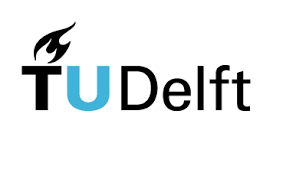 Although Japan is famous for their creations in origami, the craft is appreciated around the world, and recently by TU Delft researchers in the Netherlands who sought to understand more about folding mechanisms for complex efficient structures. Their findings are fully outlined in ‘Hyperbolic origami-inspired folding of triply periodic minimal surface structures,’ by Sebastien J.P. Callens, Nazlı Tümer, and Amir A. Zadpoor.
Although Japan is famous for their creations in origami, the craft is appreciated around the world, and recently by TU Delft researchers in the Netherlands who sought to understand more about folding mechanisms for complex efficient structures. Their findings are fully outlined in ‘Hyperbolic origami-inspired folding of triply periodic minimal surface structures,’ by Sebastien J.P. Callens, Nazlı Tümer, and Amir A. Zadpoor.
The Dutch researchers point out at the beginning of their study that geometries from triply periodic minimal surfaces—those that locally minimize an area, with vanishing mean curvatures present—have received a great amount of attention lately due to their potential for:
- High yield stress
- Low elastic modulus
- High fatigue resistance
- Bone-mimicking transport properties
And while TPMS structures are found to be ‘ideal for bone substitutes,’ the researchers explain that they are also suitable for creating a variety of structures that may be photonic, architected, or porous. They see obstacles in creating cellular structures, however, that can only be 3D printed in the form of lattices and are ‘incompatible with the planar functionality-inducing processes.’ As a result, the point of their research is to reduce constraints, while encouraging folding mechanisms, and innovating with new structures via sheet stretching. The authors also tweak the title of this new form of production from origami to origomu, since they are folding rubber instead of paper sheets—with ‘gomu’ meaning rubber.
Minimal material programming is required, and complex porous structures can be created this novel folding method:
“The rationale behind our approach consists of realizing curved minimal surface patches from a flat state, by combining rigid foldable frames with pre-strained elastomer sheets. Multiple of these foldable patches could then be connected together in a net and used as building blocks to fold a myriad of 3D TPMS-based architectures, ranging from single unit cells to larger assemblies consisting of multiple unit cells and 3D stackable minimal surface layers,” state the authors.

Geometry of TPMS and patch folding. (a) A translational P unit cell decorated with the hyperbolic *246 tiling of the fundamental asymmetrical patch. (b) Alternative patches to tile the P surface, shown together with the conventional unit cell. (c) The four TPMS considered here. From left to right: P, D, CLP, and C(P) surface. (d) Folding kinematics for the straight-edged skew polygonal patches of the P, D, CLP, and C(P) surfaces, respectively.
The concept of creating a TPMS structure in a saddle-shaped 3D puzzle form is the focus of the research, with their work using surfaces tiled by ‘straight-edged skew polygonal patches (homeomorphic to a disk).’
“A necessary (but not sufficient) condition therefore is the existence of embedded straight lines in the TPMS, which are axes of two-fold rotation and form the “linear skeletal net” of the surface,” state the researchers.
Polygonal patches are flattened with hinges attaches to boundary frame vertices, with edge lengths constant. This type of engineering allows for continuous folding of the frame to a flat polygon.

Connecting patches. (a) The edge-connection of two P patches. (b) The vertex-connection of two D patches. A transparent patch indicates a patch that fits in between two vertex-connected patches. (c) When trying to conform the hyperbolic (6,4) tiling of the D surface to the flat plane, one frequently encounters overlaps in the 2D net. (d–g) The folding of TPMS unit cells consisting of vertex-connected patches.
The patches can be connected to form more substantial minimal surfaces, resulting in a foldable 2D net, which then results in a 3D portion of the TPMS. Taking that one step further, the nets can continue to be connected, making even larger assemblies. Frames were 3D printed on an Ultimaker 2+ FDM printer, using PLA, with a 0.25 mm diameter nozzle and a layer thickness of 0.6 mm.
“We physically realized our self-folding minimal surface structures by attaching stretched elastomer sheets to 3D printed foldable frames,” said the researchers. “Upon release, the strain energy in the sheets causes the flat polygonal frame to self-fold into the desired skew polygonal configuration, and the sheet spanning the frame adopts an energy-minimizing saddle-shaped geometry, approximating the minimal surface.”
For this study, the authors narrowed their focus to four different TPMS types, but other minimal surfaces could be constructed if desired; in fact, they predict that a variety of different morphologies could be created.
“In this work, we focused on sheet-based structures, but beam-based lattices derived from the boundary frames could also be folded,” concluded the researchers. “Finally, our approach is not strictly bound by a specific length scale, meaning that it could also inspire the self-folding of architectural-scale tensile structures, nor is it limited to specific constituent materials, as long as a sufficient area distortion of the sheet surfaces and the rigidity of the boundary frames can be obtained.”

Self-folded physical models. (a) 3D-printed foldable frames for the four patch types in flat (top row) and folded (bottom row) configurations after the stretched latex sheets have been attached. (b) The mean curvature estimated using the 3D reconstructions of the four patch types obtained from micro-computed tomography data. (c) 3D-printed foldable TPMS unit cells in the flat (top row) and folded (bottom row) configurations. (d) The self-folding of the CLP unit cell through the pre-tension present in the latex sheet. (e) An assembly of four D unit cells in the flat (left) and folded (right) configurations. All scale bars are 20 mm.
Origami is an Asian craft so ancient that no one is sure whether it began in China or Japan, but Japanese artists have certainly made it their own over time. And because so many creative and scientific endeavors revolve around the creation of complex geometries and structures, origami has been an ongoing inspiration. In 3D printing, designers have also been inspired by the folding paper shapes to create complex structures for surgical implants, soft robotics, and even 4D printing to fabricate stronger metamaterials. Find out more about how origami is improving triply periodic minimal surface structures here.
What do you think of this news? Let us know your thoughts; join the discussion of this and other 3D printing topics at 3DPrintBoard.com.
[Source / Images: Hyperbolic origami-inspired folding of triply periodic minimal surface structures]
Introducing Our Two New Materials!
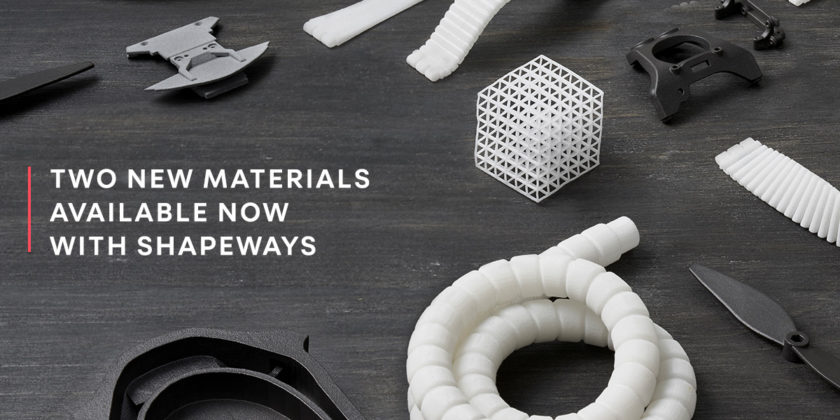
Whether you’re an entrepreneur in the midst of expanding your business or a first-time creator experimenting with a new product, your idea deserves the highest quality materials. While 3D printing is an ever-expanding industry, here at Shapeways we’re committed to staying on top of the latest cutting-edge technologies to ensure you have all you need to innovate your industry. A large part of that pledge is consistently diversifying our range of materials so that we always have the perfect match for your product’s specific needs. Today we’re excited to announce the addition of two new maker materials to the platform: PA12 Glass Beads and TPU (thermoplastic polyurethane). These two new materials are maker materials meaning they will only be available for purchase on own models and not available on the marketplace.
PA12 Glass Beads
PA12 Glass Beads is a new addition to the material family formerly known as “Professional Plastic” that we’re renaming “Multi Jet Fusion Plastic.” PA12 Glass Beads is a glass-filled nylon printed with HP MJF technology. This material offers high stiffness and high structural integrity. Translation: large and flat products will print with ease, without the concern of warping or distortion. PA12 Glass Bead’s resilience and strength make it an ideal material for projects within the medical, robotics, and drones industries, particularly for applications like flat parts, fixtures, and tooling. It’s currently available in two finishes: Gray and Dark Gray.
TPU (Thermoplastic Polyurethane)
Highly flexible and shockingly durable, thermoplastic polyurethane is a vast improvement from our previously offered elastoplastic. TPU’s elasticity and natural resistance to most every day wear make it an excellent candidate for automotive and medical use. It would work wonders as an insole, midsole, or helmet; and for robotics applications, TPU could be used for tubing, hoses, and seals.
We’re so excited to see how these new materials will expand the realm of what’s possible with Shapeways. PA12GB and TPU are now available on our site for your own models. Upload your design, select one of these two exciting materials, and get an instant quote now.
The post Introducing Our Two New Materials! appeared first on Shapeways Magazine.

